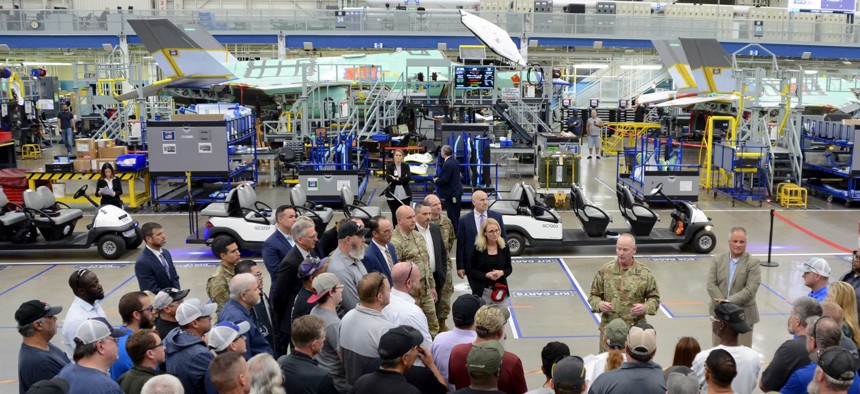
F-35 Joint Program Executive Officer Lt. Gen. Michael Schmidt talks to workers at Lockheed Martin’s Air Force Plant 4 in Fort Worth, Texas, on Nov. 3, 2022. Chief Petty Officer Matthew Olay / F-35 Joint Program Office
F-35 deliveries could resume in July, but the new jets won’t be combat-ready for a year or more
Program officials also say they’ll “reimagine” their upgrade plan, with new delays for some capabilities.
Nine months after the Pentagon stopped accepting new F-35s, the program has international consensus on a plan: resume taking the jets if their balky software upgrade can be released in a stable if limited form.
That could come as early as July, but a combat-ready version of the software won’t arrive for another 12 to 16 months, the program’s leader told lawmakers on Tuesday.
Since July 2023, the Pentagon has refused to accept deliveries of new F-35s from Lockheed Martin because of software problems with Technology Refresh-3, which will give the aircraft the extra computing power needed for Block 4 improvements to sensors and weapons. The new tech was supposed to be fielded last April, but has been delayed multiple times and the Pentagon doesn’t know when it will be fully ready.
“I am as frustrated as you that I can’t nail down a specific date and be extremely clear about exactly when we will deliver,” F-35 Program Executive Officer Lt. Gen. Michael Schmidt told lawmakers during a House Armed Services tactical air and land forces subcommittee hearing Tuesday.
The “best chance” the program has is to accept jets before TR-3 is fully finished, Schmidt said. Under this “truncated” plan, the Pentagon will receive jets loaded with an interim version of the TR-3 software.
The Joint Strike Fighter Executive Steering Board, which is a group of representatives from the U.S. and international F-35 partners, “has agreed to the criteria by which we truncate and when I get a stable, capable, maintainable software version, and terms and conditions of a contract of truncation with industry, then we can truncate it,” Schmidt told reporters at the hearing.
This version will have “stable” and “capable” code to use in training, but full combat capability won’t arrive for another 12 to 16 months, said Rep. Rob Wittman, R-Va., chairman of the subcommittee.
Schmidt agreed with Wittman’s timeline and said, “We are looking at everything we can to try to figure out what if we move left in that, but that is an accurate assessment: for a couple of the capabilities that our warfighters feel are required to be fully combat-capable, they will not be there at the truncation.”
Officials argue that a part-capability is better than nothing, and this plan would get the undelivered jets out of long-term storage, where they are collecting dust while TR-3 gets developed. Schmidt didn’t say how many are being stored, but that it was a “significant number.”
In January, Lockheed officials said the number could reach 100 to 120 jets.
In the best-case scenario, Schmidt said, the Pentagon could start accepting jets in July with the first software release. But he noted that an independent review team placed that timeline more likely at August or September.
“Future risks hinge upon whether TR-3 will require additional incremental software releases to test and implement critical fixes. If risk manifests in labs or flight test, TR-3 may require additional software releases (taking between two and six weeks per release),” Schmidt wrote in his testimony.
The problems with TR-3 do not affect jets currently in the U.S. inventory.
The F-35 program has faced a slew of development problems, mostly due to excessive “concurrency,” which means that a system goes through development and procurement at the same time, making it harder to fix problems in testing.
“We have signed ourselves up to pipe dreams with concurrent programs and a long set of capabilities for a lot of reasons that we decided, ‘Well, I have to have it, so it'll be done in this timeframe,’ without the engineering rigor required to get those capabilities to actually get into the airplane, and all the things that go with that,” Schmidt said.
Program officials want to change that with a plan to “reimagine” Block 4 and define “must-have” capabilities that industry will actually be able to deliver, according to his testimony.
Through “Reimagined Block 4,” the program will lay out a plan to deliver upgrades in a “combat-relative timeframe” with a subset of capabilities already planned in the program, but only those that “give us the most bang for the buck,” Schmidt told lawmakers.
“Reimagined Block 4 will likely include common capabilities for electronic warfare; communication, navigation, and identification; sustainment, and new weapons for the partnership, plus U.S. service-unique capabilities and partner-unique capabilities. Reimagined Block 4 must consist of “what industry can actually deliver” across the Future Years Defense Program and be consistent with the JESB-directed development funding cost cap,” Schmidt wrote.
As directed by Congress, the Pentagon will also formally establish Block 4 as a standalone subprogram within the next year, Schmidt said.
Lockheed declined to comment and said it's in a quiet period ahead of its earnings call next week.




